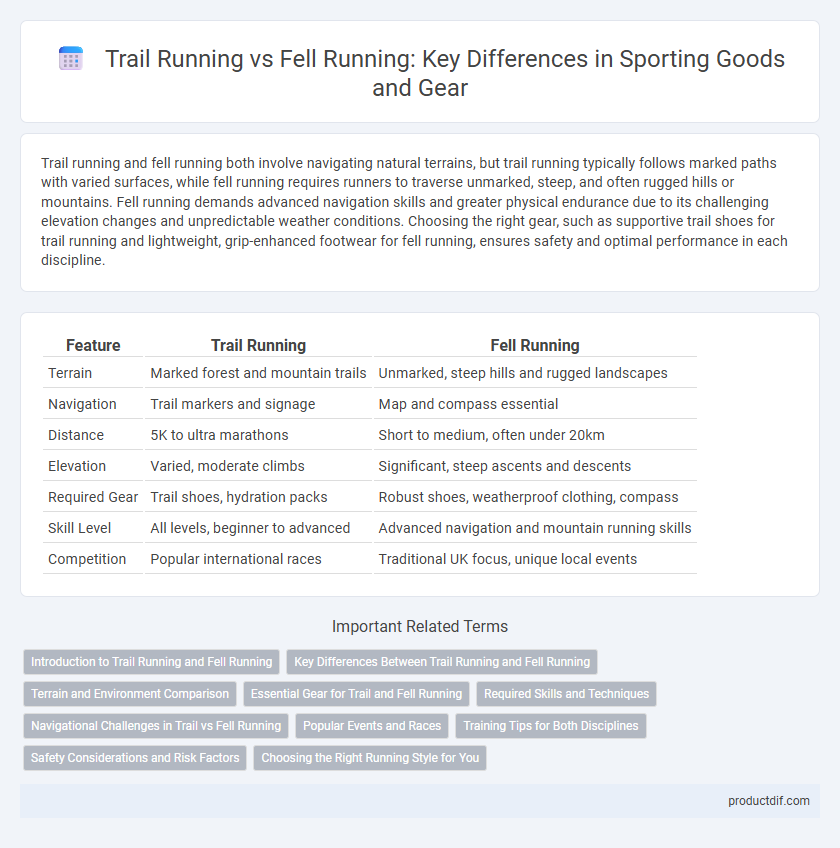Trail running and fell running both involve navigating natural terrains, but trail running typically follows marked paths with varied surfaces, while fell running requires runners to traverse unmarked, steep, and often rugged hills or mountains. Fell running demands advanced navigation skills and greater physical endurance due to its challenging elevation changes and unpredictable weather conditions. Choosing the right gear, such as supportive trail shoes for trail running and lightweight, grip-enhanced footwear for fell running, ensures safety and optimal performance in each discipline.
Table of Comparison
| Feature | Trail Running | Fell Running |
|---|---|---|
| Terrain | Marked forest and mountain trails | Unmarked, steep hills and rugged landscapes |
| Navigation | Trail markers and signage | Map and compass essential |
| Distance | 5K to ultra marathons | Short to medium, often under 20km |
| Elevation | Varied, moderate climbs | Significant, steep ascents and descents |
| Required Gear | Trail shoes, hydration packs | Robust shoes, weatherproof clothing, compass |
| Skill Level | All levels, beginner to advanced | Advanced navigation and mountain running skills |
| Competition | Popular international races | Traditional UK focus, unique local events |
Introduction to Trail Running and Fell Running
Trail running involves running on marked paths or trails, often through forests and mountainous terrain, emphasizing endurance and navigation skills. Fell running is a form of off-trail running in upland areas, predominantly in the UK, requiring participants to climb steep gradients without defined paths. Both sports demand physical fitness and agility but differ in terrain, marked routes, and regional origins.
Key Differences Between Trail Running and Fell Running
Trail running involves running on marked paths with varied terrain, emphasizing endurance and speed over smoother, more predictable surfaces. Fell running occurs on upland country with steep gradients, requiring advanced navigation skills and the ability to handle rough, often unmarked routes. Key differences include navigation demands, terrain difficulty, and elevation challenges, with fell running being more technical and physically demanding.
Terrain and Environment Comparison
Trail running typically occurs on well-marked paths through forests or mountains, featuring varied terrain such as dirt trails, rocks, and roots that require agility and balance. Fell running takes place in more rugged, open landscapes like upland moors and steep hills, demanding exceptional navigation skills and endurance due to its often pathless, uneven ground. The environment in fell running is usually more exposed to unpredictable weather conditions, adding an extra challenge compared to the more sheltered and accessible routes in trail running.
Essential Gear for Trail and Fell Running
Essential gear for trail running includes lightweight, breathable trail shoes with aggressive tread for varied terrain, hydration packs or bottles, and moisture-wicking apparel to manage sweat. Fell running demands more rugged, waterproof footwear with enhanced grip for steep, muddy slopes, alongside weather-resistant clothing and a map or compass for navigation in remote, unmarked areas. Both disciplines benefit from technical socks, GPS watches, and lightweight layers suited to rapid weather changes in outdoor environments.
Required Skills and Techniques
Trail running demands strong endurance, agile footwork, and the ability to navigate uneven terrain using precise balance and quick reflexes. Fell running requires advanced hill-climbing skills, efficient uphill pacing, and expert navigation in remote, often pathless landscapes. Both styles emphasize adaptability to weather and terrain, but fell running places a greater emphasis on map reading and route choice under challenging conditions.
Navigational Challenges in Trail vs Fell Running
Trail running often features well-marked paths and established routes, reducing navigational challenges for runners. Fell running demands advanced navigational skills as courses commonly lack clear trails and rely heavily on map reading and compass use across rugged, open terrain. Mastery of terrain recognition and quick decision-making is crucial in fell running to safely and efficiently follow race routes.
Popular Events and Races
Trail running features popular events like the Western States 100 and the Ultra-Trail du Mont-Blanc, known for their challenging terrains and international appeal. Fell running highlights iconic races such as the Wasdale Fell Race and the Ennerdale Horseshoe, celebrated for their steep gradients and navigation skills in the Lake District. Both disciplines attract dedicated athletes seeking diverse environments and endurance challenges.
Training Tips for Both Disciplines
Trail running training emphasizes building endurance and strength on varied terrain by incorporating hill repeats, long-distance runs, and stability exercises. Fell running demands enhanced agility and quick reflexes due to steep, uneven surfaces, so athletes focus on technical descending skills, interval training, and proprioceptive drills. Both disciplines benefit from cross-training with core strengthening and flexibility workouts to prevent injuries and improve overall performance.
Safety Considerations and Risk Factors
Trail running and fell running both demand heightened attention to safety due to uneven terrain, but fell running involves steeper gradients and less-defined paths, increasing the risk of falls and navigation errors. Proper footwear with strong grip, detailed route planning using topographical maps, and carrying emergency supplies are essential for minimizing injuries in both sports. Weather changes can severely impact visibility and footing, making real-time monitoring of conditions critical for fell runners navigating remote, exposed landscapes.
Choosing the Right Running Style for You
Trail running emphasizes varied terrain with established paths, offering moderate elevation changes and a safer, more accessible experience suitable for beginners and those prioritizing scenic routes. Fell running involves steep, rugged, and often pathless landscapes, demanding advanced navigation skills, superior fitness, and a strong connection with challenging natural environments. Selecting the right running style depends on your skill level, terrain preference, and fitness goals, balancing safety with adventure intensity.
Trail running vs fell running Infographic

 productdif.com
productdif.com